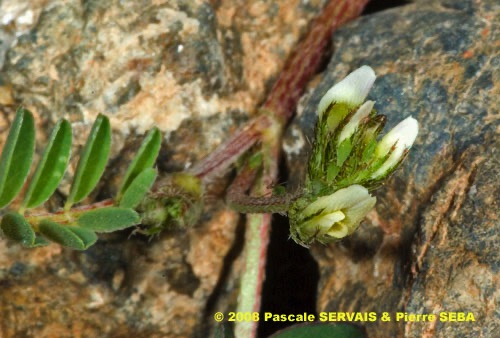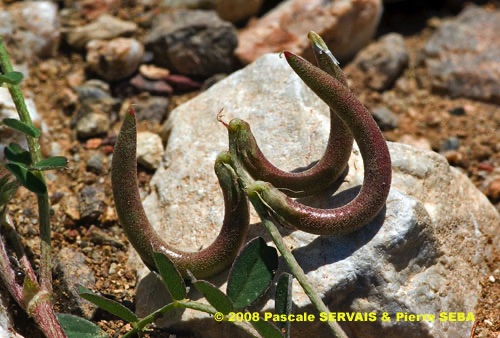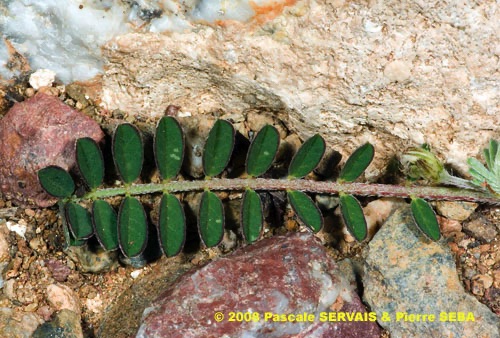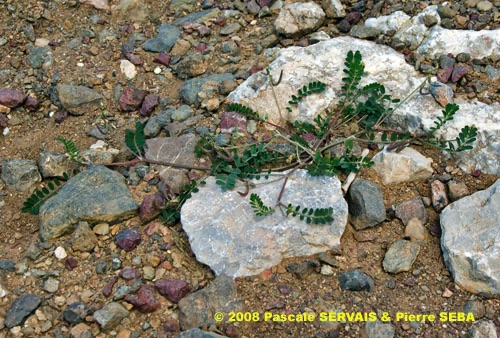
Astragalus hamosus L.
Fam. : Fabaceae
© Pascale SERVAIS & Pierre SEBA, 2018. Tilo Botanica: Flore de Tilos et du Dodécanèse / Flora of Tilos and of the Dodecanese
English translation by Brenda Bradbury, Howard Bradbury and Stéphane Léonard
Plante herbacée, hermaphrodite, à tiges étalées à rampantes, couvertes de poils courts.
Feuilles alternes, composées imparipennées, de 15 cm de long au plus, à 17 à 25 folioles de 7 à 8 mm de long, oblongues, échancrées au sommet, glabres dessus, un peu poilues dessous, avec la plupart des poils en T. Stipules soudées ensemble.
Fleurs à symétrie bilatérale, blanc jaunâtre, de 5 à 10 mm de long, réunies par 5 à 14 en grappes d’abord denses et globuleuses puis lâches et ovales, portées par un pédoncule deux fois plus court que la feuille sous-jacente. Corolle papilionacée. Ailes plus longues que la carène. Calice à sépales de 7 à 8 mm de long, soudés entre eux jusqu’à la moitié, avec des poils noirs sur la pointe. 9 étamines soudées entre elles et 1 libre. Ovaire supère.
Fruits, gousses courbées, linéaires, falciformes en demi-cercle à presque annulaires, de 20 à 50 mm de long et 3 à 4 mm de large, lisses, presque glabres.
___________________________
Plant herbaceous, hermaphrodite. Stems spread out to trailing, covered in short hairs.
Leaves alternate, compound imparipinnate, 15 cm long at most, with 17 to 25 leaflets from 7 to 8 mm long, oblong, indented at the top, glabrous on the upper surface, a little hairy on the lower surface, with the majority of the hairs T-shaped. Stipules fused together.
Flowers bilaterally symmetrical, white yellowish, from 5 to 10 mm long, joined together by 5 to 14 in racemes, initially dense and globulous, then loose and ovate, carried by a peduncle twice shorter than the underlying leaf. Corolla papilionaceous. Wings longer than the keel. Calyx with sepals from 7 to 8 mm long, fused with each other as far as half, with black hairs on the point. 9 stamens fused with each other and 1 free. Ovary superior.
Fruits, curved, linear pods, sickle-shaped in half rings to almost annular, from 20 to 50 mm long and 3 to 4 mm across, smooth, almost glabrous.
Descripteurs / Identifying features
1

2

3

4
Étymologie / Etymology :
Astragalus : emprunt du latin astragalus, -i (nom) = l’astragale, nom
donné au pois chiche par Pline, naturaliste latin mort en 79 apr. J.-C.,
forme latinisée du grec ancien ἀστράγαλος, -ου (nom) = la vertèbre,
l’osselet, nom donné à la plante par Dioscoride, médecin et botaniste
grec mort en 90 apr. J.-C., en référence à la forme des graines
semblables à des osselets.
Hamosus : adjectif créé par les botanistes [ < hamus, -i (nom)
= le crochet, l’hameçon ] = qui se courbe en forme d’hameçon,
qui a la forme d’un hameçon, en référence à la forme du fruit.
Astragalus : borrowed from Latin astragalus, -i (noun) = astragalus,
name given to chick-pea by Plinius, Latin naturalist died in 79 AD,
Latinized form of the Classical Greek ἀστράγαλος, -ου (noun)
= vertebra, ossicle, name given to the plant by Dioscorides,
Greek doctor and botanist died in 90 AD, referring to the shape of
seeds similar to ossicles.
Hamosus : adjective created by botanists [ < hamus, -i (noun)
= hook, fish-hook ] = which is bent as a hook, hook-shaped,
referring to the shape of the fruit.
Synonymes / Synonyms :
Ankylobus hamosus (L.) Steven
Astragalus ancistron Pomel
Astragalus brachyceras Ledeb.
Astragalus buceras Willd. ex Schltr.
Astragalus dorcoceras Bunge
Astragalus hamosus subsp. brachyceras (Ledeb.) Batt.
Astragalus hamosus var. buceras (Willd. ex Schltr.) Rouy
Astragalus volubilitanus J.Braun & Maire
Hamaria uncinata Fourr.
Hamosa astragalus Medik.
Tragacantha hamosa (L.) Kuntze
Noms vernaculaires / Common names :
Nom français / French name :
Astragale à gousses en hameçon.
Noms anglais / English names :
European milkvetch — Hooked milkvetch — Southern milk vetch.
Noms allemands / German names :
Haken-Tragant — Hakenfrüchtiger Tragant.
Noms espagnols / Spanish names :
Anzuelos — Hedisaro — Securidaca menor.
Noms italiens / Italian names :
Astragalo con legumi uncinati — Astragalo falciforme.
Habitat :
Cultures - Lieux pierreux - Lieux incultes - Chemins.
Cultivated places - Stony places - Waste ground - Waysides.
Île / Island :
Tilos.
Hauteur / Height range :
De 10 cm à 30 cm.
From 10 cm to 30 cm.
Floraison / Flowering time :
De février à juin.
From February to June.
Groupe / Classification :
Dicotylédones.
Dicotyledons.
Pérennité / Lifespan :
Annuelle.
Annual.
Description :
Clés dichotomiques et descripteurs distinctifs des 4 espèces / Dichotomous keys and distinctive identifying features of the 4 species
Photo 1 :
Localisation / Location : Tilos, Megalochorio, Plaka
Date : 16/04/2008
GPS : Lat. 36,46375° N / Long. 27,30546° E / Alt. 38 m
Type : Photographie numérique / Digital Photograph (10 mégapixels)
Photo 2 :
Localisation / Location : Tilos, Megalochorio, Plaka
Date : 16/04/2008
GPS : Lat. 36,46375° N / Long. 27,30546° E / Alt. 38 m
Type : Photographie numérique / Digital Photograph (10 mégapixels)
Photo 3 :
Localisation / Location : Tilos, Megalochorio, Plaka
Date : 16/04/2008
GPS : Lat. 36,46375° N / Long. 27,30546° E / Alt. 38 m
Type : Photographie numérique / Digital Photograph (10 mégapixels)
Photo 4 :
Localisation / Location : Tilos, Megalochorio, Plaka
Date : 16/04/2008
GPS : Lat. 36,46375° N / Long. 27,30546° E / Alt. 38 m
Type : Photographie numérique / Digital Photograph (10 mégapixels)

Google Maps
Google Maps
Google Maps
Google Maps